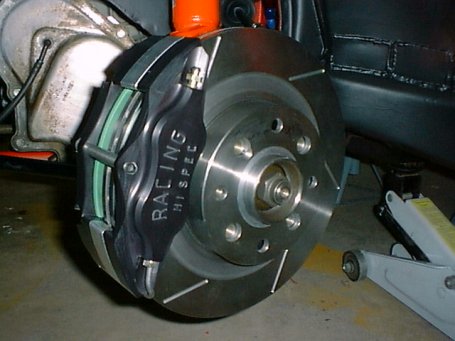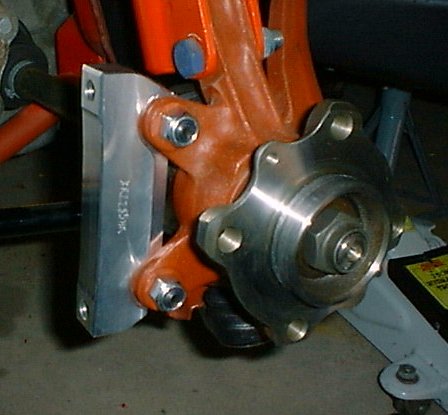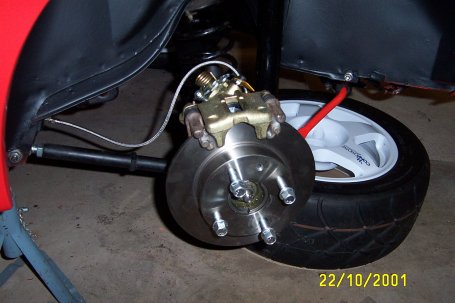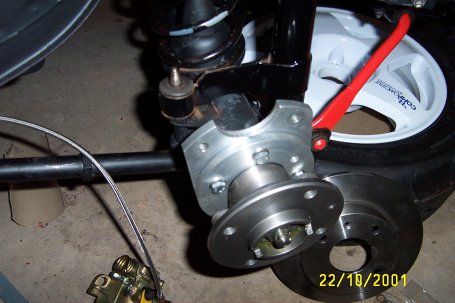Brakes - Page 2
LastThe Servo (or the Power Assist Vacuum Booster)
On the stock road-going version of the Fiesta, a brake servo takes the force applied to the brake pedal, amplifies the force, which is then fed in to the brake master cylinder.Brake servo's are not common on race cars, and indeed are often fitted to compensate for an error in the design of the braking system. They take a vacuum feed from the inlet manifold, which is quite tricky to plumb in when you have a manifold like the one I'm using, with four seperate isolated runners, individually feeding each inlet port. So I'm not using a Servo, instead I've chosen to use a bias adjuster assembly as detailed below.
Front brakes

I opted for HiSpec Engineering billet 4-pot front calipers. These allow the use of 285mm ventilated disks, and fit on to the existing Fiesta hubs by way of an adaptor. Overbraided front hoses were made to my design by Earls, and these connect the calipers via M10 fittings, to the cupro-nickel hydraulic pipe.
I'm using Ferodo DS2500 brake pads in the front and rear brakes.

Rear brakes
2009 update
In 2009, I changed to a standard rear axle with Focus Mk1 stub axles bolted on to the ends of the Mk1 Fiesta axle. This was again manufactured by Rutland Performance Vehicles. I went this route because I wanted to convert the Fiesta centre rear disk kit to use wheel nuts instead of studs. Drilling the rear hubs out to accept the Rally Design wheel bolts, cracked both of the rear hubs. Because the Fiesta Centre hubs are essentially made from 'turned down' Fiesta Mk1 rear drums, this exercise just showed how weak the cast drums actually are. So by moving to a Focus rear stub axles, and Focus hubs, I have removed the risk of the weak Fiesta centre hubs breaking whilst competing.
As part of the conversion, I'm staying with rear disk brakes, and I'm now running a 'thinned and cross drilled' rear Focus disk, and a pair of underslung HiSpec single pot rear calipers. The benefit of running bolted on rear stub axles is that the camber can be altered by shimming the axles where they bolt on to the Fiesta axle, and I can also run Puma/Fiesta rear spacers, which means I no longer have to run wheel spacers trapped between the rim and the disks, which also helps reduce the rotating mass of the rear wheels.
Prior to 2009

I bought the Fiesta Centre rear disk brake conversion kit. It comprises of a machined aluminium plate which the caliper bolts on to, a modified rear brake drum which is machined to allow a disk to be fitted, a pair of Fiesta Mk3 solid front brake disks, and an assortment of fixings. You will also need to buy a pair of Ford Granada (Mk3) Scorpio rear brake calipers. I bought my calipers from Halfords. The calipers have identical part numbers to those used on the Sierra Cosworth.

I opted to modify the mounting brackets supplied by the Fiesta Centre. My first rose jointed adjustable trailing arms were manufactured by TAS, and they interfered with the caliper if you mounted it in the 8 O'Clock position. So I drilled one new hole in the mounting plate, which allowed it to be rotated to mount the caliper at the 12 O'Clock position. I also had to have the drums turned down a fraction on the lathe, as they hadn't been machined properly, and when bolted in place, locked against the mounting plate. The Fiesta Center were made aware of the problem, but at the time had used a different manufacturer of brake drums, so there were some difference in tolerances.
Master Cylinders (pre-2006)
For this theoretical piece, I'm using a 0.625" front master cylinder, and a 0.75" rear. The input force applied to the master cylinders is halved, because of the brake bias assembly. So applying 714 lbs of force on the brake pedal, results in 307 lbs of force on each master cylinder, assuming that the bias bar is set at 50:50.


